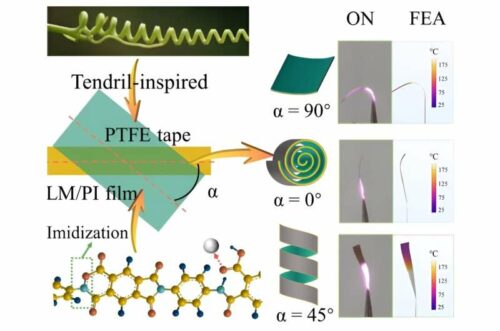Discover how these innovative devices offer rapid responsiveness, incredible stability, and endless possibilities for flexible robotics, smart devices, and bionic systems.

A research endeavour spearheaded by Prof. Tian Xingyou and Prof. Zhang Xian at the Hefei Institutes of Physical Science (HFIPS), affiliated with the Chinese Academy of Sciences (CAS), has harnessed the potential of liquid metal to create Liquid metal/Polyimide/Polytetrafluoroethylene (LM/PI/PTFE) programmable photothermal actuators based on asymmetric thermal expansion. Dr. Li Xiaofei, the study’s lead author, drew inspiration from how the tip-sensitive region of a plant undergoes contraction on one side to form tendrils, thus shaping their innovative approach.
Liquid metals, a class of flexible photothermal materials known for their reinforcement properties without the need for additional polymers, are emerging as formidable contenders in the realm of photothermal actuators. Researchers are fervently working to expand the capabilities of liquid metal photothermal actuators to propel them into robotic motion. In this endeavour, the research team successfully crafted a photothermal actuator by ingeniously combining liquid metal and polyimide (LM/PI) film with PTFE tape, a configuration mirroring the ability of plants to seek out sunlight. The LM/PI film served as both structural support and the photothermal layer, while the PTFE tape emulated the role of protoplasm, capable of contracting and bending under specific conditions.
Li Xiaofei elaborates on this innovation, emphasising that configuring the PTFE tape at different angles relative to the LM/PI film curls akin to tendrils, thus endowing the actuator with programmable morphological characteristics. The resultant actuator showcased remarkable traits such as substantial deformation, swift responsiveness, outstanding stability, and a commendable load-bearing capacity. These attributes hold immense promise for driving progress in flexible robotics, smart devices, and bionic systems, potentially revolutionising their practical applications.
The researchers undertook to model the actuator, leveraging finite element analysis to predict its precise bending morphology. This approach to programmable initial morphology, combined with predictive modelling, enabled the design of versatile robots capable of crawling, rolling, swimming, grasping, and handling tasks. This development in the realm of photothermal actuators lays the foundation for future advancements in bionic systems and robotics, ushering in a new era of possibilities, as affirmed by the research team. The marriage of liquid metal technology with programmable photothermal actuators holds immense promise for the future of innovative engineering and intelligent systems.






